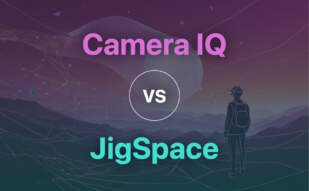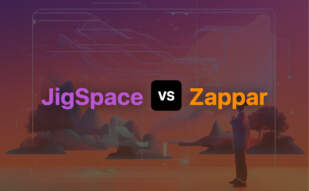JigSpace is a cutting-edge AR product presentation company that has revolutionized product communication. It has been featured in major events like Apple Vision Pro announcement and is known for its ability to simplify complex product explanations through immersive AR experiences. With compatibility across various platforms and customizable branding features, JigSpace has become a go-to tool for enhancing product understanding in various settings.
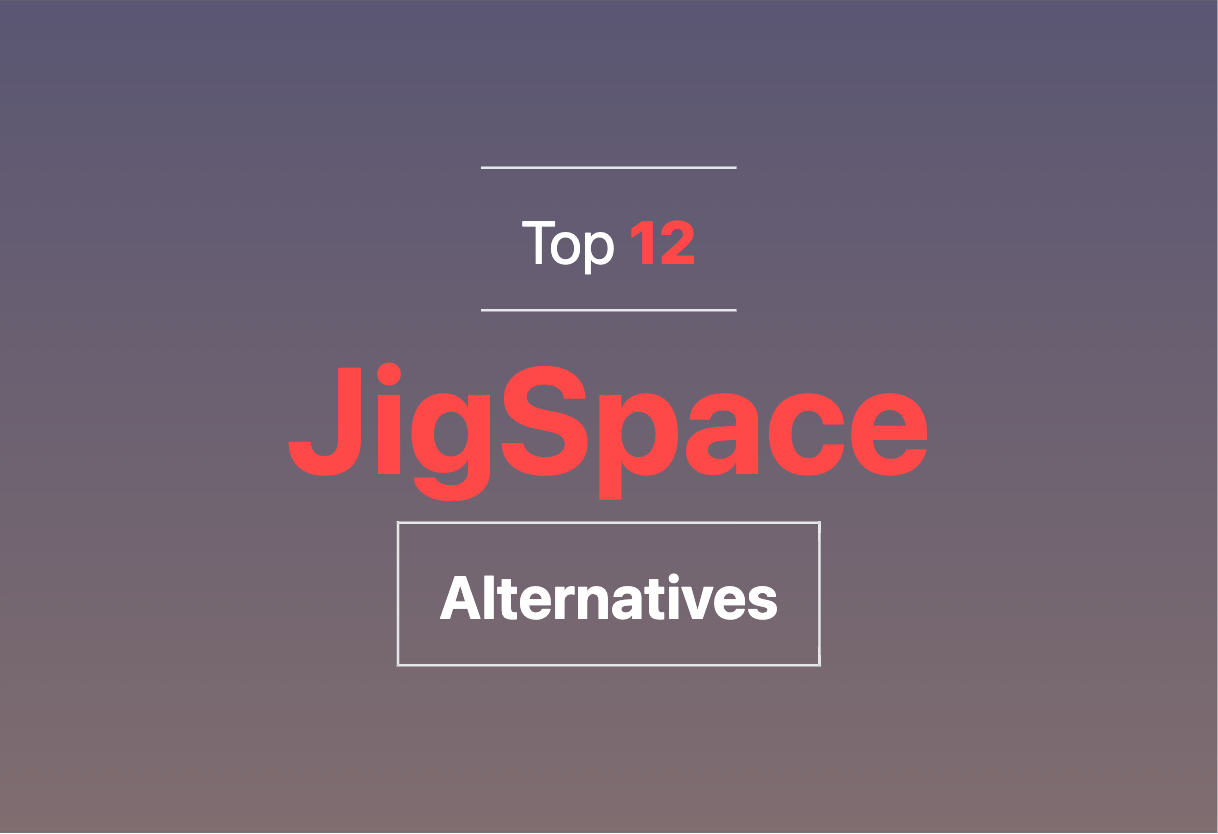
For those exploring alternatives to Three.js, alternatives worth considering are WebGL, WebGL 2, WebVR, WebXR, OpenXR, React Three Fiber, p5.js, Pixi.js, Babylon.js, A-Frame, X3DOM, Deck.gl, and VTK.js.
Aircada

Embark on a journey of seamless Augmented Reality content creation with Aircada, a no-code platform revolutionizing AR experiences. Born in 2020 from the minds of Sean and Wylie Chenoweth, Aircada prioritizes intuitive, business-oriented AR solutions. It caters to creatives and corporates alike, making waves as the “Canva” of AR content creation.
Aircada’s Top Features
- Compatible across mobiles, tablets, and lidar-equipped gadgets
- Effortless 3D model scanning and uploading
- Streamlined operations with integrated AR content management system
- Highly intuitive, automatic graphic creation
- Cutting-edge Spatial AI algorithms
- Ample documentation and guidance
- Fast and efficient WebGPU utilization
| Security | Encrypted communication |
|---|---|
| Team Collaboration | Collaborate and create with your team |
| Language Support | Support for multiple languages to cater to a global audience |
| Regular Feature Updates | Dedicated to enhancing user experience |
Aircada’s Limitations
- While the platform excels in many areas, its emphasis on ease and speed might not cater to all who desire a more complex, nuanced AR creation process.
- The platform’s broad features presume a learning curve, even with their robust documentation.
Aircada Pricing
Aircada offers the most competitive FREE edition, replete with countless features. As your needs evolve, you can opt for plans starting at approximately $20 per month to an enterprise plan of about $79 per month.
Aircada Use Cases
Use Case 1: Marketers
Aircada empowers marketers with interactive AR experiences, enabling engaging storytelling and brand promotion.
Use Case 2: 3D Designers
3D designers will find Aircada’s 3D model scanning capabilities invaluable, offering a wider canvas for creativity.
Use Case 3: Industrial Equipment Firms
Companies in the industrial equipment sector can use Aircada for comprehensive guided AR procedures and training, minimizing risks and enhancing productivity.
Unity

Behold Unity, a herald in the realm of game development engines. Established in 2005, Unity has risen to prominence, shaping worlds in 3D and 2D games and exploring the unchartered vistas of Augmented Reality (AR).
Unity’s Top Features
- An adaptable system compatible with multiple operating systems, paving the path for creations that span the horizon from AR to 3D simulations.
- Offers a suite of tools, cutting-edge rendering technology, and an assortment of features to imbue life into high-quality games.
- Features a rich asset store, loaded with a myriad of pre-conceived textures and features, stoking the fires of ingenious game designs.
- Supports a variety of coding languages, including BOO script, Javascript, and C#, acknowledging the multilingual spirit of developers.
- Sustains an active developer community aimed at assistance, problem-solving, and feedback, acting as the harbingers of continuous system improvement.
| Unity Version | Features |
|---|---|
| Free | Included with essential features, this version facilitates the creation of refined games. |
| Pro | With a wealth of substantial features, this version transcends the boundaries of possibilities for ambitious game developers. |
Unity’s Limitations
- Developers have expressed concerns over the new pricing model that charges a fee for each installation of games developed through Unity, leading to potential economic disincentives for solo, indie, and mobile developers.
- The lack of transparency in pricing changes has sparked distrust amongst users, thus creating a rift in the relationship.
- Concerns over how sudden pricing shifts could compromise developers’ financial sustainability round off the list of significant downsides.
Unity Pricing
The pricing plan of Unity offers both free and paid versions. However, the redesigned pricing model set to come into effect on January 1, 2024, has developers paying a fee each time a game using Unity software is installed, subject to certain constraints and caps.
Unity Use Cases
Integration with Multiple OS
Unity’s adaptability with various operating systems enables developers to create an array of applications, from engrossing 3D simulations to riveting AR experiences.
Assisting Game Design
An abundant asset store combined with varied coding language support offers developers vast resources to ideate, develop, and hone game designs, rendering it an indispensable tool.
Creator Community
Unity thrives on community interaction, driving collective action to provide valuable assistance, problem resolution, and insights for systemic improvements, thus making it an operating environment conducive for collaboration and mutual growth.
EasyAR
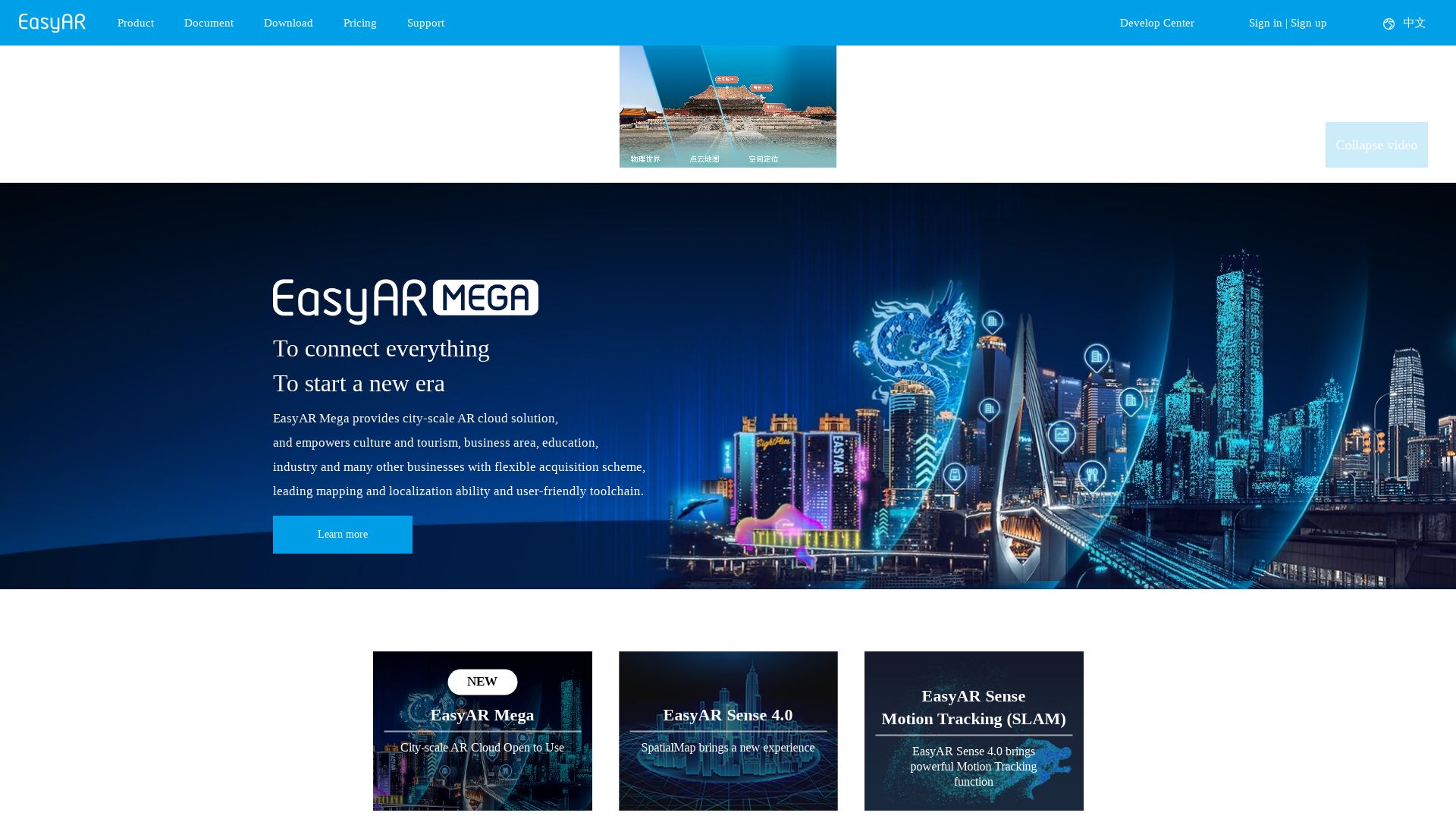
As a platform for Augmented Reality application development that was established in 2012 in China, EasyAR offers both local and cloud-based solutions. It integrates breathtaking AR features using a single RGB camera to capture spatial information from the physical environment, pairing it up with handy integrations, via an API access.
EasyAR Top Features
- Relocalization and persistent AR content for a seamless user experience.
- Single RGB camera for capturing physical environment spatial info, thereby enriching the AR experience.
- AR Cloud Image Recognition and target management, aiding user interactivity with the AR environment.
- EasyAR Sense 4.0 comes equipped with algorithm components and motion tracking capabilities.
- The SenseMARS software platform offers functionalities: perception intelligence, AI-enabled AR, MR content generation, and cloud engine support.
- Offers city-scale mapping, localization ability and user-friendly toolchains for more comprehensive AR experiences.
| AR Configurator, AR Measurement, and AR Floor Tiling | Enhances real-world interaction |
| Automatic dynamic lighting and reflections | Augments the overall visual appeal |
| AR Occlusion feature | Improves realism of virtual objects |
EasyAR Limitations
- Unfeasible pricing could be a hindrance for some companies.
- There is a lack of optimization and could result in less-than-optimal performance.
- Limited web support restricts its usability across various platforms.
EasyAR Pricing
EasyAR services can be availed at the cost of $39/month, and a free trial is available for users to test out the platform before deciding to subscribe.
EasyAR Use Cases
Use case 1 – Retail
EasyAR’s AR visualization and 3D engine software ability enhances the shopping experience by enabling customers to visualize products in a real-world context before making a purchase.
Use case 2 – Education
By employing perception intelligence and artificial intelligence capabilities, EasyAR can generate engaging and interactive educational content, thereby catering to modern and innovative teaching methods.
Use case 3 – Industrial Maintenance and Repair
With capabilities like AR floor tiling and measurement, EasyAR can provide detailed pictorial instructions and virtual demonstrations, thereby simplifying machinery servicing or maintenance tasks.
Onirix

Based in Spain, Onirix is a distinctive platform specializing in Augmented Reality (AR) content creation and Web AR services for a plethora of sectors. It is uniquely tailored to cater to professionals, developers, and non-technical users targeting efficient AR service UX improvement.
Onirix Top Features
- AR content creation and publishing service, offering the capacity for user interaction and transition between multiple elements.
- Facilitates incorporation of diverse content such as 3D models, videos, audio files, etc. into AR experiences.
- Features a WebAR player that enables smooth content sharing across digital platforms.
- Offers a specialized Experience Editor designed for those without technical know-how.
| Feature | Generation |
|---|---|
| Direct AR visualization | Real-time, inside the web browser, eliminating the need for an app. |
| Control over access permissions | Integration with Unity via SDK for iOS device permission management. |
Onirix Limitations
- Pricing could be a concern for smaller companies.
- No ‘pay as you go’ license model for occasional users or projects on pause.
Onirix Pricing
Onirix offers several options for pricing, starting at €89 per month. A free version and trial version are also available making it accessible to wide range of users.
Onirix Use Cases
Use case 1: Agencies
Onirix could be an accessible choice for agencies searching for a powerful yet simple-to-use AR content creation tool.
Use case 2: Non-profits and IT services
Non-profits or IT services that need a user-friendly platform for creating and sharing AR content via WebAR could benefit immensely from Onirix. The integration of audio files, videos, and 3D models can enhance their digital presence.
Use case 3: Retailers and Restaurants
The geolocation feature of Onirix could be a game-changer for retailers and restaurants looking to offer interactive maps or immersive engagement campaigns to their customers.
Adobe Aero
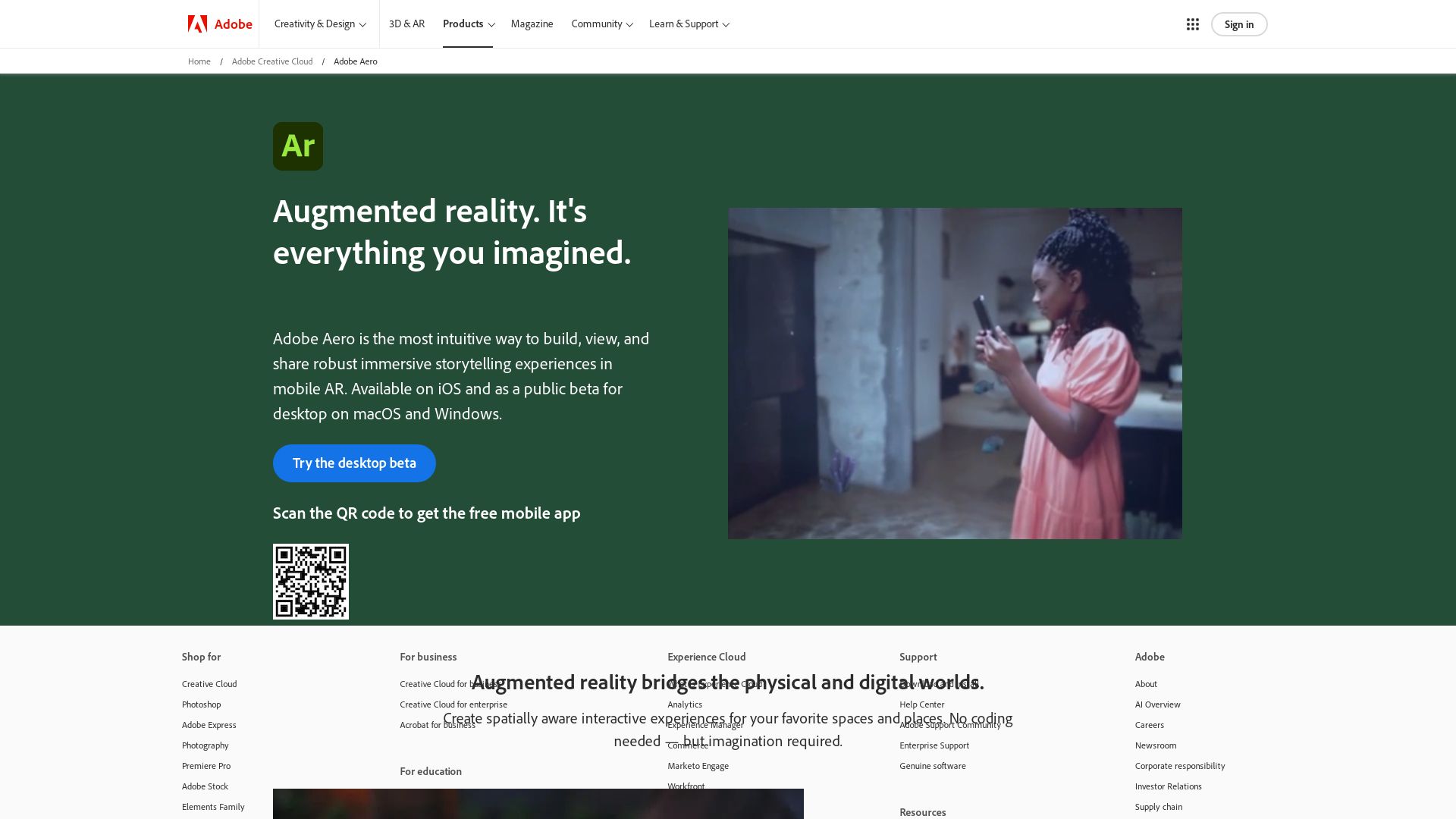
Meet Adobe Aero, a pioneering AR creation tool embedded in the heart of Adobe’s creative ecosystem. Intuitive to use and designed for simplified AR development, it empowers you to build immersive AR experiences without complex coding or 3D design skills.
Adobe Aero Top Features
- No coding or 3D design necessary, enabling creators to focus on innovative content.
- Interactive experiences with behavioral content triggers and object motion paths – an intuitive, sustainable solution to greenifying the digital landscape.
- Preview mode for visualizing edits and testing interactions, supporting the iterative creative process.
- Integration with Adobe Photoshop, Illustrator, and other Creative Cloud applications, enhancing workflow efficiencies.
| Adobe Aero | Details |
|---|---|
| Sharing Power | Supports App Clips and no Aero app installation is necessary, which results in faster loading experiences. |
| Viewer Mode | Allows interaction with the creation and makes changes publishable via the shared link or QR code. |
| Updates | Stability and performance improvements, supporting users on iOS 16+. |
Adobe Aero Limitations
- Exclusively available to iOS devices, which can limit the accessibility for some users.
- It lacks some of the advanced features found in other AR platforms, indicating room for future enhancements.
- Users might encounter potential limitations and bugs, as noted by some user experience reviews.
Adobe Aero Pricing
While the pricing is not explicitly mentioned, Adobe Aero is part of the Adobe Creative Cloud suite. Each plan comes with different pricing tiers reflecting the chosen package and services.
Adobe Aero Use Cases
Use case 1: Artists
With its intuitive design and seamless integration with Adobe Creative Cloud, Adobe Aero unleashes the 3D-arist’s potential, breathing life into 2D designs.
Use case 2: Educators
Educators leveraging Adobe Aero can create engaging, interactive learning environments that captivate students and promote retention.
Use case 3: Marketers
Marketers can use Adobe Aero to develop immersive advertising experiences, enhancing consumer engagement and thereby, greening brand visibility.
ARCore
Developed by the tech titan Google, ARCore is a top-notch tool for crafting compelling augmented reality experiences. Gaining momentum from the technologies refined through Tango, ARCore provides an array of APIs to empower mobile devices with the ability to comprehend and interact with their surroundings.
ARCore Top Features
- Motion Tracking: ARCore flawlessly tracks your phone’s movement and aligns digital content with precision.
- Environmental Understanding: While in use, ARCore smartly integrates with your real-world context, enhancing your AR experience.
- Light Estimation: ARCore accurately gauges the environment’s lighting to render realistic-looking graphics.
- Geospatial Depth API: This feature offers improved depth measurements, utilizing building and terrain data.
- Streetscape Geometry API: A feature that provides a 3D mesh around your location within a 100m radius.
| API | Functionality |
|---|---|
| Geospatial API | Integration with Google Maps for location-based AR experiences |
| Scene Semantics API | Deploys AI to label each pixel in an outdoor AR scene |
| Google Play Services for AR | Auto-installation and updates for AR experiences built with ARCore |
ARCore Limitations
- Reported compatibility issues with Google Maps live view.
- Unauthorized installation of Google Apps flagged by users.
- Limited to functioning on devices running Android 7.0 (Nougat) and above.
ARCore Pricing
Good news! ARCore is a free offering from Google, opening the gateway to a world of breathtaking AR experiences without pinching your pocket.
ARCore Use Cases
Use case 1
For App Developers, ARCore is a treasure chest filled with comprehensive APIs, offering increased opportunities to build or enhance apps with engaging AR capabilities.
Use case 2
Brand Marketers can make the most of ARCore for crafting immersive AR ad campaigns, providing interactive experiences, and driving customer engagements.
Use case 3
For Game Developers, ARCore is the perfect pick. It provides a wide-ranging toolkit for creating mesmerizing mobile gaming experiences that blend smoothly with the real-world context.
ARKit
Propelling forward technological evolution, ARKit as an augmented reality platform of Apple, has been expanding the horizons of AR since its launch back in 2017, and continues to improve with each iOS update. Breaching boundaries across gaming, shopping and industrial sectors, ARKit can introduce dynamic virtual objects into your reality, transforming your device into a window to a vibrant virtual world.
ARKit Top Features
- Supports 4K video capture for enhanced AR experiences, useful in video editing, film production and social media applications
- Enables HDR video and high-resolution background image capture for top-tier visual augmentation
- Elevated Motion Capture capabilities that can accurately record and mirror human movements
- Simultaneous use of front and back cameras, allowing interactions with AR content using facial expressions
- People Occlusion, letting AR content pass behind and in front of people in a realistic manner
| ARKit 4 | ARKit 5 |
|---|---|
| Boosts depth sensors to improve tracking and object detection | Introduces Advanced rendering with RealityKit 2 |
| Adds object capture and character control capabilities |
ARKit Limitations
- Work best in environments with good lighting and a flat surface needed for visual odometry
- AR experiences might falter without input from sensors like cameras, accelerometers, and gyroscopes
ARKit Use Cases
Use case 1 – Film Production and Social Media Applications
With its 4K video capture and HDR video capabilities, ARKit can produce stunning videos and images for film production and social media applications, magnifying creative storytelling.
Use case 2 – Enhancing Gaming Experiences
Integrating virtual objects into user’s reality, ARKit escalates gaming experiences, by offering a seamless blend of the virtual and real world. Gamers, brace for a captivating immersive experience.
Use case 3 – AR in Shopping
ARKit’s potential in revolutionizing the shopping industry is immense, offering customers a virtual try-on, improving decision-making and shopping satisfaction.
ZapWorks
Enter the universe of ZapWorks, an innovative AR ecosystem catering to designers, developers, and marketers alike. With its vivid suite of tools, you can effortlessly craft standout WebAR experiences using no-code, low-code, or custom code options.
ZapWorks Top Features
- Zapworks Designer: Intuitive drag-and-drop functionality, requires no apps, downloads or coding for impactful WebAR creation.
- Zapworks Studio: Perfect for AR content creation, it merges the ease of a visual UI with the flexibility of a robust code editor.
- Tracking types: World tracking for product visualisations, mini-games, volumetric video, avatars, and image tracking for overlaying digital content on products, print & packaging. It also features face tracking which allows for realistic, feature-rich facial animations.
| Feature | Description |
|---|---|
| Enterprise-scale Deployment | Included branding, hosting, priority support, security, and more for large businesses. |
| AR Education | Specialist AR training for producing high-impact AR experiences. |
| ZapWorks Studio 6 | Aims to lower the tech-barrier for creating interactive short-form mobile content, emphasising usability and efficiency. |
ZapWorks Limitations
- User experience is not always ideal, with some critics implying limited creative freedom or restrictions on using industry standard formats.
- Some features such as world tracking and cylindrical tracking for WebAR are reported as limited.
- Though noted for its ease of use, some users have reported challenges with the platform.
ZapWorks Pricing
ZapWorks offers varied pricing options suitable for personal, business, or educational use, as well as for embedding in apps. Precise pricing details can be accessed via the company’s website.
ZapWorks Use Cases
Use case 1: Prototyping:
Considered a leading AR platform, ZapWorks empowers businesses to prototype products, fuel innovation, and boost their marketing & sales efforts.
Use case 2: Education:
Beyond businesses, ZapWorks also finds extensive use in educational environments, enhancing classroom learning and practical training programs.
Use case 3: AR-centric Communication:
ZapWorks is ideally suited for AR-centric communication with regular updates and community events like the Zapworks Hackathon – a celebration of creativity and AR community expansion.
Blippar
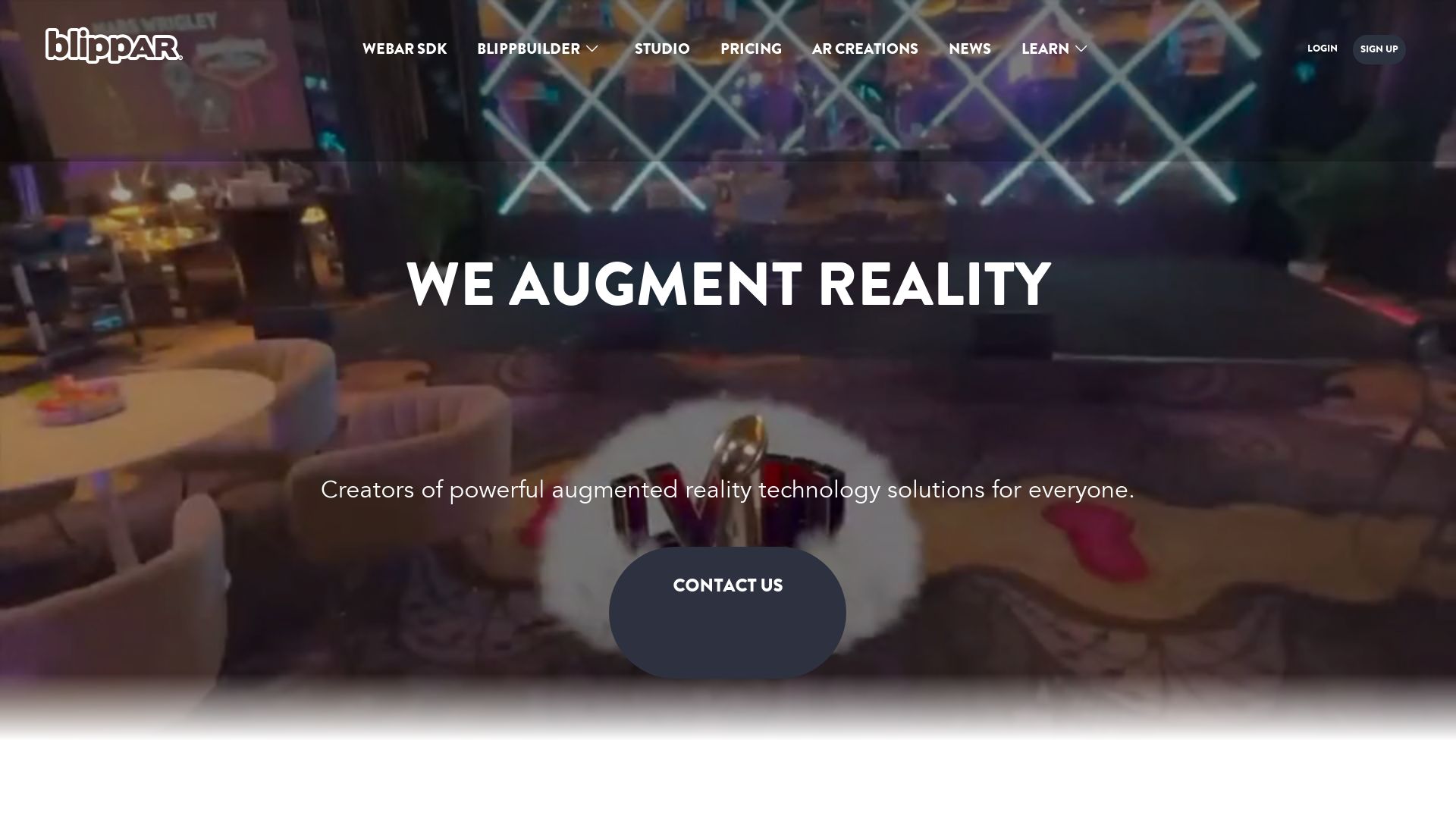
Introducing Blippar, the UK’s first tech unicorn making strides in the AR content creation and publishing sector. Founded by respected tech leaders in 2011, the company flourished under the guidance of its current CEO, Faisal Galaria.
Blippar Top Features
- First-class Augmented Reality tool offering content creation and design studio facilities.
- Among the first to transition from AR experiences to a SaaS platform for AR creation.
- Blippbuilder- a free-to-use, no-code AR creation tool caters to the tech-savvy and newbies alike.
- Pioneered mobile-based AR technology primarily for advertisers.
- Expansive partnerships with conglomerates such as GSK, Porsche, Jaguar Land Rover, and PepsiCo.
| Noteworthy Achievements | Feature |
|---|---|
| World’s first AR product launch with OnePlus Nord | AR Product Launch |
| Recognized by CNBC, Bloomberg, and Fast Company | Industry Recognition |
Blippar Limitations
- Faced financial turbulence leading to insolvency proceedings in 2018.
- Blippar’s vision for complex projects over fun ones may not cater to all users.
Blippar Pricing
Blippar’s pricing details are reserved and need to be directly obtained from the company. However, their Blippbuilder tool is free-to-use.
Blippar Use Cases
Use case 1 – Advertisers
With Blippar’s initial product being a smartphone-based AR tool for advertisers, it serves as an innovative platform for creating resonant ads with a futuristic twist.
Use case 2 – Businesses looking for visual recognition tools
Blippar’s AR technology extends to facial and car recognition APIs, making it phenomenally useful for businesses seeking visual searchability and smart solutions.
Use case 3 – Product Launches
The world’s first AR product launch with OnePlus Nord testifies Blippar’s capacity to turn product launches into incredible AR experiences, making it an apt fit for companies thinking about high-tech, memorable rollouts.
Wikitude

An innovative contender in the Augmented Reality landscape, Wikitude hails from Salzburg, Austria. Emerging in 2008, it originally offered location-based AR experiences through the World Browser App, that has bolstered its prowess as an AR developer’s tool overtime.
Wikitude Top Features
- Software Development Kit (SDK): Launched in 2012, the kit specializes in image recognition and tracking, plus geolocation.
- Integration Flexibility: Compatible with Android, iOS, and Windows OS, and optimized for smart eyewear devices, strengthening its universality.
- Specialized Tracking Mechanisms: Allows recognition and tracking of multiple 2D images in challenging environments using its advanced image tracking technology.
- Sophisticated AR Features for Unity Experts: Introduced with ‘SDK 9.0 Expert Edition’ in 2020.
| KEY HIGHLIGHTS | DETAILS |
|---|---|
| SLAM Technology | Introduced in 2017, SLAM (Simultaneous Localization And Mapping) tech aids object recognition and tracking, markerless instant tracking. |
| Cylinder Tracking | You can create AR experiences with cylinder-shaped targets with the cylinder tracking. |
| Multiple Trackers | Positional tracking is combined with object and image tracking to introduce multiple trackers. |
Wikitude Limitations
- The accuracy of GPS, compass, and motion sensors used in Wikitude’s location-based AR has generated some debate regarding its qualification as true AR.
- While Wikitude supports ARKit and ARCore, it does not integrate them directly, which might complicate its usage.
Wikitude Use Cases
Use Case 1: Image Recognition
With its advanced image recognition technology, Wikitude is particularly useful for games and immersive learning platforms that require instant triggering of AR experiences.
Use Case 2: Geo-tagged AR experiences
Travel and hospitality businesses can build location-based AR guides or interactive visits using Wikitude’s powerful geolocation feature.
Use Case 3: Unity-based Projects
Unity experts aiming for high-performing AR solutions can harness the best of Wikitude’s advanced AR capabilities introduced in the ‘SDK 9.0 Expert Edition’.
Vuforia
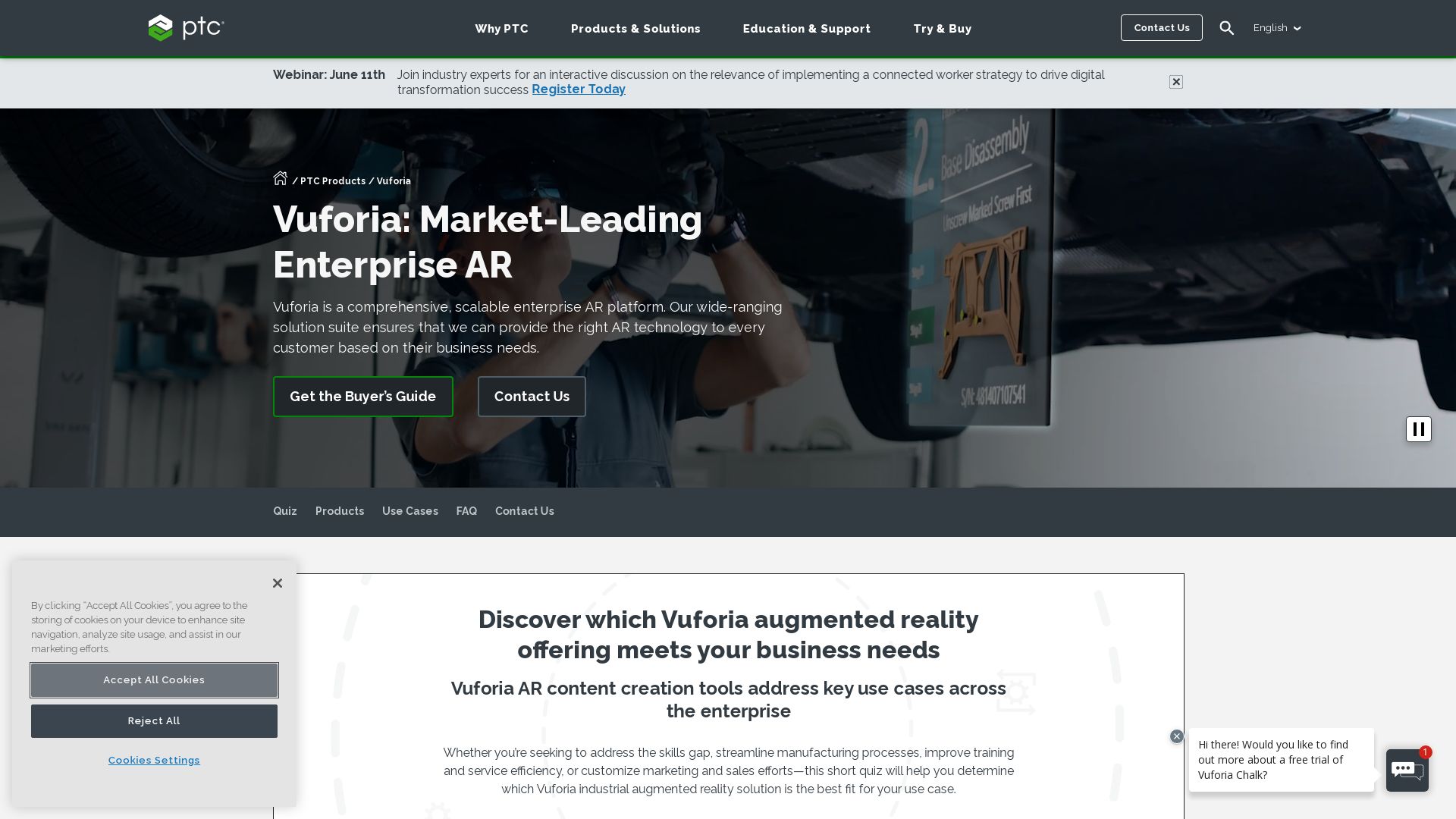
A robust Augmented Reality software development kit (SDK), Vuforia was born from the innovation lab of Qualcomm and later acquired by PTC Inc. in 2015. Made by and for visionaries, Vuforia has etched its mark by enabling the creation of impressive AR applications through its computer vision technology capable of object recognition.
Vuforia Top Features
- Supports both 2D and 3D target types
- APIs available in several languages such as C++, Java, and more for Unity game engine
- Compatible with several platforms including iOS, Android, and UWP
- Comes with appealing plans like Basic and Premium that meet different needs, even extendable with Cloud add-ons
- Special focus on AR Digital Twin which bridges physical and digital spaces
- Recognized and chosen by more than 800,000 developers worldwide
| Key Benefits | Compatibility |
|---|---|
| Image and object recognition, extended tracking, model target capabilities | Unity, Android Studio, Visual Studio, XCode platforms |
| Dynamic recognition and targeting options | AR headsets/glasses like HoloLens 1, Magic Leap, RealWear HMT-1, Vuzix M400 |
| Creative empowerment | Windows 10, iOS, Android devices |
Vuforia Limitations
- Deprecating Virtual Buttons: Future versions will remove this feature
- Minimum support for Unity is version 2022.3.5f1+
Vuforia Pricing
Vuforia offers a flexible pricing structure. There’s a Free Develop Version for learning and non-commercial use, then the Basic and Pro versions which are paid. More extensive features and cloud add-ons come at an extra cost, with the cloud add-on overage offered at a standard rate of $0.01/Cloud record. All plans, excluding the Premium one, are cancellable.
Vuforia Use Cases
Use Case 1: 3D Product Demonstrations
With Vuforia’s 3D object recognition capability, companies can create innovative 3D product demonstrations that provide customers an immersive experience.
Use Case 2: Interactive Marketing Campaigns
Vuforia assists in designing interactive marketing campaigns through its cutting-edge AR applications, driving customer engagement to new highs.
Use Case 3: Off-site Project Visualization
Architects and engineers can benefit from Vuforia to create AR representations of their projects, enabling off-site visualization and team collaboration.
Augment

The limelight in the tech world’s red carpet today is Augment, a brilliant star in the Augmented Reality universe. Imagine enhancing your real-world environment with a generous sprinkle of digital visual elements, cue 3D sound effects or other sensory stimuli – voila, that’s Augment for you!
Augment’s Top-tier Features
- Interactivity that gets hearts racing – thanks to computer-generated visual elements overlaid on the real world!
- Enables businesses to flex their marketing muscles by launching engaging campaigns.
- Your sales might just need a treadmill, because they’re due for a serious boost due to the interactive user experience.
- Whether print out sheets are your enemies, or the idea of a new AR world gets you nibbling pencil tips, with Augment, both marker-based or marker-less AR types are available.
| Application | What it Does |
|---|---|
| Industrial Manufacturing | Allows for safe equipment handling and enhanced collaboration in workspace |
| Medical Training | Visualize sneaky 3D images of body systems for an immersive learning experience |
Augment’s Limitations
- Hardware conundrum: The ultimate AR experience with Augment requires specific hardware components such as sensors, a processor, display and input devices.
Augment Use Cases
Retail
Create a fitting room without walls! Augment allows customers to visualize your products in different environments right from their couch. Imagine running a clothing store where pants never run out of sizes.
Entertainment
Gone are the days when a flat TV screen was the only source of amusement. With Augment, enter a realm where 3D images leap out, resulting in a gaming experience that gives reality a run for its money.
Architecture
Ever imagined constructing a building on your desk? With Augment, bring your architectural designs to life, an experience that’s better than dreaming with open eyes.
Hannah Stewart
Content writer @ Aircada, tech enthusiast, metaverse explorer, and coffee addict. Weaving stories in digital realms.



